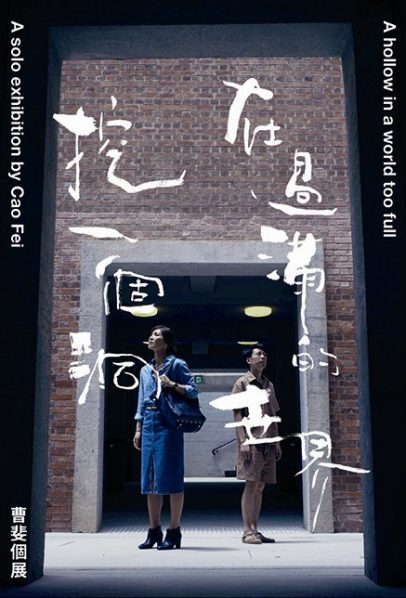
From September 8 to December 9, UCCA presents Cao Fei’s first?institutional?solo exhibition in?China, at Tai Kwun Contemporary?in Hong Kong. The exhibition?features the artist’s newly commissioned work,?Prison Architect,?a new film that is shown here in a specially conceived installation setting. The film, directed by Cao Fei and commissioned by Tai Kwun Contemporary, centers on two fictional characters separated by time but connected by the space in which the exhibition itself unfolds: an inmate of the Victoria Prison which forms an integral part of Tai Kwun (played by the artist Kwan Sheung Chi), and an architect tasked with converting this prison into a gallery (played by Valerie Chow Kar Ling).
The exhibition?is curated by UCCA Director Philip?Tinari?with?Xue?Tan. In addition to?Prison Architect, it includes a selection of works from the last ten years of Cao?Fei’spractice, a period during which she has focused?on?film and installation art,?exploring?alternative realities, automated?futures,?and?derelict?dreams. Cao Fei’s?artistic repertoire partakes of?social commentary, popular aesthetics, Surrealist references, and documentary conventions. The exhibition title, taken from a line in the film, also evokes the ways in which her work?describes?the?chaotic changes?withincontemporary Chinese?reality, yet creates hollows,?set apart?from this reality,?in?whichto question?and reflect upon?it.
The?prisoner and architect of?Prison Architect?speak to each other across?time: these buildings?once formed?Victoria Prison, Hong Kong’s earliest penal institute. Decommissioned in 2006,?they have?now been transformed into a thriving cultural institution. This layered history adds to the artwork’s meaning,?overlaying?threedisparate?temporalities—those in which the two protagonists are trapped, and that of the viewer—in the same space.?Prison Architect?explores?colonial history, cinema, and China’s?shifting relation to the world.?The film,?commissioned for this exhibition, marks the first collaboration between Cao Fei and the award-winning Hong?Kongcinematographer Kwan Pun Leung.
Other works on view present?Cao Fei’s?rich imaginings of different?worlds—whether apocalyptic, virtual,?or automated.?The installation,?Rumba,?is named after the diminutive?cleaning robot—normally a domestic sidekick but?promoted, here, to the protagonist of a brave new world of Cao Fei’s imagining.?I Mirror?recounts?her?initial plunge into the online?community?of Second Life, where she spent ten hours a day on her digital avatar, China Tracy;?the work anticipates?the growing appeal of virtual reality in?youth cultures across the globe.?RMB City,?also constructed in Second Life in the lead-up to the Beijing Olympics,?is a?Chinese?metropolis?and a?hodgepodge of structures,?permanently under construction.?La Town’s creolized title hints at the?strange, heterogeneous blend of people who populate its elaborate, decidedly analogue,?architectural models; the film is an exploration of decadence and decline—halfway through, a nameless catastrophe strikes, and the city is?turned?into a dystopia. Finally,?in?Coming Soon,?Cao?counterposes?twins sitting on swings, manically beating drums with their feet, in a parody of recreational happiness.
The exhibition evinces?Cao’s?rigorous commitment to finding new expressive vocabularies, and her continued engagement with the people who populate, create, and encounter her work.
About?the Artist
Cao Fei (b. 1978, Guangzhou; lives and works in Beijing) is among the most internationally renowned artists of her generation. She has shown in biennials and triennials in Venice, Istanbul, Sydney, Yokohama, Moscow, Taipei, Shanghai, and Guangzhou, and at museums including the Guggenheim,?MoMA, Serpentine Gallery, Tate Modern, Centre Pompidou,?Palais?de Tokyo,?Fondation?Louis Vuitton, Long Museum, and UCCA. Named the “Best Young Artist” (2006) and the “Best Artist” (2016) by the Chinese Contemporary Art Awards, she staged her first retrospective at MoMA P.S.1 in 2016, and will present another at K21 Düsseldorf this fall.
About UCCA
UCCA is China’s leading independent institution of contemporary art. Founded in 2007 in Beijing’s 798 Art District, it presents exhibitions of artists Chinese and international, public programs, research projects, and outreach initiatives to a public of over one million annual visitors.
About Tai Kwun?Contemporary
Tai Kwun Contemporary is the contemporary art programming arm of Tai Kwun,dedicated to presenting contemporary art exhibitions and programs as platforms for a continually expanding cultural discourse in Hong Kong. Operated by the contemporary art team, Tai Kwun Contemporary is an integral part of Tai Kwun at the Central Police Station compound, Hong Kong.
Working with other like-minded institutions and art groups to present the highest standards of exhibition-making and art programming, Tai Kwun Contemporary hosts six to eight curated exhibitions every year alongside exciting public programs. Reflecting as well as contributing to Hong Kong’s contemporary art landscape, these exhibitions affirm the city’s position as a leading international art hub in Asia. As a non-profit art center, Tai Kwun Contemporary steers free from the commercial art world.
Tai Kwun Contemporary’s exhibitions are?presented in 1500 square meters?of museum-standard galleries, designed by Herzog & de?Meuron. Additionally, within the Central Police Station compound, there are numerous?public art works specially commissioned by Tai Kwun Contemporary.
Courtesy of the artist and UCCA, for further information please visit http://ucca.org.cn/en.




























